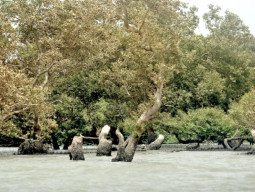
To highlight the importance of mangrove plantations and raise awareness among coastal communities and other stakeholders, the World Wildlife Fund-Pakistan (WWF), in collaboration with a courier service company, planted dozens of mangrove trees at the WWF Wetland Centre, Sandspit Beach on Saturday morning.
The activity was aimed to conserve the ecological significant plants which serve as a nursery ground for different marine species and lessen the intensity of sea hurricanes.
“We intend to raise awareness among people so that they know how these plants are pivotal for their own environment,” explained the WWF-P Sindh’s conservation manager, Altaf Hussain Shaikh. He informed the participants that his organisation carried out such plantation activities three to four times a month.
Shaikh was of the view that such activities had considerably changed the attitude of the people towards mangroves as they actively participated in the plantation drives now. He said that the survival rate of mangrove samplings was about 70 per cent. “The due care after plantation is a pre-requisite,” he stressed.
“Planting more mangroves and creating awareness among people are two major objectives of these activities,” elaborated Naveed Ali Soomro, the project coordinator.
Soomro briefed the participants about the mangroves’ importance for the environment, its existence and the reasons associated with the decline of forests and mangroves.
“I had no idea before the briefing how and why these trees are important for us,” commented a participant, Hasan Raza. “Lack of alternative energy resources and dearth of fresh water has disturbed our environment.” Raza stressed that different stakeholders, including private companies, should take initiatives for planting more mangroves and running awareness campaigns.
Shaikh told The Express Tribune that those who had participated in plantation activities loved and cared for the mangroves, adding that plantation and awareness activities were fruitless until and unless people had a sense of ownership for the sea forests.
Soomro reported that approximately 90 per cent of the mangrove forests existed across Sindh’s coastal belt with only 10 per cent mangroves found in Balochistan’s coastal boundary. “Mangroves produce oxygen and inhibit heavy storms by acting as wind breakers.” He said that trees were being threatened as local communities were cutting them for fuel wood.
Published in The Express Tribune, September 15th, 2013.
COMMENTS (1)
Comments are moderated and generally will be posted if they are on-topic and not abusive.
For more information, please see our Comments FAQ






























1713853507-0/MalalaHilary-(2)1713853507-0-270x192.webp)








We want mangrove plants for 15 acars land. Can any body advice for plants arrangement?